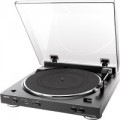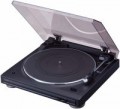Model
Model of the pickup (cartridge) supplied with the player. The pickup is one of the most important parts of any vinyl player, the quality of the received sound largely depends on its quality. Knowing the name of the model, you can find detailed data on it and determine how satisfied you are with this particular cartridge.
Features
—
Tempo adjustment. The presence in the player of an electronic module that allows you to change the tone of the sound being played, in other words, to make it higher or lower by a certain interval, in other words, change the playback speed. This feature is also known as a "pitch controller". It is relevant primarily for DJ "turntables", as it allows you to mix tracks recorded in different keys. Some home players also have a tempo control, but its capabilities are much more modest, and a real need for such a function rarely arises.
—
Adjustable counterweight. The ability to adjust the position of the counterweight mounted on the opposite end of the tonearm from the cartridge. This allows you to change the balance of the tonearm by adjusting the downforce (see above); the presence of an adjustable counterweight is highly desirable if you plan to use "non-native" pickups with the player.
—
Anti -skating. The presence of an anti-skating system in the design of the tonearm. The peculiarities of the work of the vinyl player are such that during playback there is an additional force that presses the needle against the inside of the groove. This results in an imbalance in the sound of the stereo channels and uneven groove wear. To compensate for this phenomenon, anti-skating is used — a system that “pulls” the tonearm in the opposite direction, towards the ou
...ter edge of the record. Anti-skating may be based on counterweights, springs, magnets, or other devices, but anyway, this function is considered highly desirable for modern turntables. However, it is not available everywhere: for example, in low-cost models, anti-skating may not be provided to reduce the cost, and in top-end devices it may be present, but not indicated in the specifications.
— Reverse playback. The reverse function allows you to play the record in reverse, playing the sound backwards. This feature is unlikely to be needed by audiophiles, but it is very much appreciated by DJs, as it expands the arsenal of available sound effects. Usually, direct drive is required for reverse (see above), although there are exceptions.
— Hitchhiking. A system that automatically stops the disc and raises the arm when the record has finished playing. Due to this, additional wear of the needle due to movement along the plate "idle" is prevented. However, in some situations (for example, when playing several records in a row), hitchhiking is inconvenient, so it can be turned off.
— Autoplay. The presence in the player of automatic playback. In such models, the user does not need to manually move the tonearm. In fact, it is enough to install the record, press the button — and the disc will start to rotate, the tonearm will lower itself to the desired position, and after the end of playback, the record will stop, the tonearm will rise (due to hitchhiking, see above) and return to its original position. Such systems make the player as convenient as possible, but they significantly affect its cost, and also (like any additional electronics) are a potential source of interference.
— Built-in acoustics. The presence in the player of its own speaker system, consisting of speakers and a power amplifier. This equipment allows you to listen to records without the use of external equipment; in fact, models with acoustics are stand-alone music centers, except that they work not on cassettes / discs / flash drives, but on vinyl discs. At the same time, the characteristics of the built-in amplifiers and loudspeakers are generally noticeably more modest than those of external ones, and additional electronics in the player's case can distort the signal. Therefore, it makes sense to purchase models with built-in acoustics if purity and high sound quality are not critical — for example, for listening to old records.
— Speed 78 rpm. The ability to operate the player at a speed of 78 revolutions per minute. To date, such records are almost never produced, but they were very popular until the 60s of the XX century. Therefore, to listen to vintage audio recordings, you will need a turntable with support for this speed. Note that 78 rpm operation may require additional equipment (such as a belt pulley or a special pickup).
— Write to media. The ability to connect an external media to the player and record the reproduced sound on it in digital form. Usually, we are talking about USB-drives (such as flash drives); accordingly, a USB Type A port is provided for their connection. However, other types of media, such as memory cards, may be supported. Recording directly to media is faster than digitizing via a computer (see "USB port (type B)" above), but the sound is recorded "as is" in this case, without the possibility of quality enhancement and noise filtering.
— Installation of the second tonearm. Possibility of installing an additional tonearm on the player, which can differ markedly from the main one both in its own features and in the characteristics of the pickup. This possibility is justified if the player is planned to be used in different modes that cannot be covered by a single pickup. For example, you can install an inexpensive pickup on the second tonearm, which is not a pity to “kill” on old worn records, or a 78 rpm cartridge for vintage recordings. Note that in some models there may be more than one additional tonearms.
— Pendulum alignment. Automatic turntable leveling system based on a pendulum (suspension). This feature is found exclusively in premium class models, designed for the highest mechanical precision. In such models, the player itself is installed on a special stand on the floor, and a massive (several tens of kilograms) pendulum is suspended from its lower part. While the pendulum hangs strictly vertically, the player's disc is in a strictly horizontal position; and due to the large mass, the suspension practically does not deviate from the vertical with small vibrations of the floor (for example, from people walking nearby). This feature is designed primarily for sophisticated audiophiles who want to get the most accurate and reliable sound.Power consumption
Rated power consumed by the player during normal operation.
Modern turntables are very economical: most models, even those equipped with built-in acoustics (see "Features"), the power consumption does not exceed 15 W, and there is no need to talk about any serious impact on congestion in the electrical networks (as well as electricity bills). The exception is some premium-class devices, in which the weight of the platter (see below) reaches several tens of kilograms, and the corresponding engine power is required to rotate such a mass.

